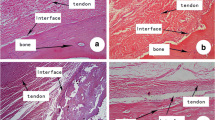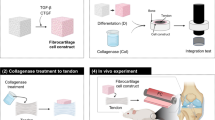Abstract
Introduction
The aim was to investigate the effect of collagen sponges (CS) as a delivery device for osteoprotegerin (OPG)/bone morphogenetic protein 2 (BMP-2) and support matrix on the tendon-bone healing after anterior crusicate ligament (ACL) reconstruction in modeled rabbits.
Materials and Methods
Sixty New Zealand white rabbits were randomly divided into four groups based on treatments they received at the tendon-bone interface after left knee ACL reconstruction: the control group, OPG/BMP-2, CS, and OPG/BMP-2/CS combination. At 4, 8 and 12 weeks post-surgery, five rabbits from each group were euthanized to examine the tendon-bone healing. Levels of OPG and BMP-2 in synovial fluid, the bone tunnel enlargement value, the histomorphological typing of tendon-bone interface, and the bone tunnel area of the tendon-bone interface were compared among different treatments.
Results
The OPG/BMP-2/CS combination treatment group had the highest levels of OPG and BMP-2 in synovial fluid (both P < 0.05), the greatest number of Sharpey-like collagen fibers at all test points (P < 0.05), the most fibrocartilage enthesis on week 12, the greatest bone tunnel area (P < 0.05), and the greatest decrease in bone tunnel enlargement on week 12 (P < 0.05). Histomorphological typing of tendon-bone interface of all groups showed changes varying from tendon-bone separation to firm healing, and the change was most significant in the OPG/BMP-2/CS combination treatment group.
Conclusion
CS treatment alone serves as a fixing support, and CS combining with growth factors OPG/BMP-2 ensures slow and stable release of OPG/BMP-2, significantly improves the tendon-bone healing in the rabbit ACL model.






Similar content being viewed by others
Change history
17 December 2021
A Correction to this paper has been published: https://doi.org/10.1007/s00774-021-01300-8
References
Anderson MJ, Browning WM, Urband CE, Kluczynski MA, Bisson LJ (2016) A systematic summary of systematic reviews on the topic of the anterior cruciate ligament. Orthop J Sports Med 4:2325967116634074
Bedi A, Fox AJ, Harris PE, Deng XH, Ying L, Warren RF, Rodeo SA et al (2010) Diabetes mellitus impairs tendon-bone healing after rotator cuff repair. J Shoulder Elbow Surg 19:978–988
Sun Z, Wang X, Ling M, Wang W, Chang Y, Yang G, Dong X, Wu S, Wu X, Yang B, Chen M et al (2017) Acceleration of tendon-bone healing of anterior cruciate ligament graft using intermittent negative pressure in rabbits. J Orthop Surg Res 12:60
Groot JA, Jonkers FJ, Kievit AJ, Kuijer PP, Hoozemans MJ (2017) Beneficial and limiting factors for return to work following anterior cruciate ligament reconstruction: a retrospective cohort study. Arch Orthop Trauma Surg 137:155–166
Nakase J, Kitaoka K, Matsumoto K, Tomita K (2010) Facilitated tendon-bone healing by local delivery of recombinant hepatocyte growth factor in rabbits. Arthroscopy 26:84–90
Zhang C, Li Q, Deng S, Fu W, Tang X, Chen G, Qin T, Li J et al (2016) bFGF- and CaPP-loaded fibrin clots enhance the bioactivity of the tendon-bone interface to augment healing. Am J Sports Med 44:1972–1982
Chen B, Li B, Qi YJ, Ni QB, Pan ZQ, Wang H, Chen LB (2016) Enhancement of tendon-to-bone healing after anterior cruciate ligament reconstruction using bone marrow-derived mesenchymal stem cells genetically modified with bFGF/BMP2. Sci Rep 6:25940
Pan W, Cao Z, Li D, Zhang M (2013) Evaluation of the potential application of three different biomaterials combined with bone morphological proteins for enhancing tendon-bone integration. Injury 44:550–557
Chen J, Yang L, Guo L, Duan X (2012) Sodium hyaluronate as a drug-release system for VEGF 165 improves graft revascularization in anterior cruciate ligament reconstruction in a rabbit model. Exp Therap Med 4:430–434
Zhai W, Lv C, Zheng Y, Gao Y, Ding Z, Chen Z (2013) Weak link of tendon-bone healing and a control experiment to promote healing. Arch Orthop Trauma Surg 133:1533–1541
Wright RW, Preston E, Fleming BC, Amendola A, Andrish JT, Bergfeld JA, Dunn WR, Kaeding C, Kuhn JE, Marx RG, McCarty EC et al (2008) ACL reconstruction rehabilitation: a systematic review part II. J Knee Surg. 21:225–234
Geiger M, Li RH, Friess W (2003) Collagen sponges for bone regeneration with rhBMP-2. Adv Drug Deliv Rev 55:1613–1629
Masci VL, Taddei AR, Gambellini G, Giorgi F, Fausto AM (2016) Ultrastructural investigation on fibroblast interaction with collagen scaffold. J Biomed Mater Res Part A 104:272–282
Huang RL, Chen G, Wang W, Herller T, Xie Y, Gu B, Li Q (2015) Synergy between IL-6 and soluble IL-6 receptor enhances bone morphogenetic protein-2/absorbable collagen sponge-induced bone regeneration via regulation of BMPRIA distribution and degradation. Biomaterials 67:308–322
Honma M, Ikebuchi Y, Kariya Y, Suzuki H (2014) Regulatory mechanisms of RANKL presentation to osteoclast precursors. Curr Osteoporosis Rep 12:115–120
Dynybil C, Kawamura S, Kim HJ, Ying L, Perka C, Rodeo SA (2006) The effect of osteoprotegerin on tendon-bone healing after reconstruction of the anterior cruciate ligament: a histomorphological and radiographical study in the rabbit. Z Orthop Ihre Grenzgeb 144:179–186
Arpornmaeklong P, Pripatnanont P, Chookiatsiri C, Tangtrakulwanich B (2017) Effects of titanium surface microtopography and simvastatin on growth and osteogenic differentiation of human mesenchymal stem cells in estrogen-deprived cell culture. Int J Oral Maxillofac Implants 32:e35–e46
Stensby JD, Kaliney RW, Alford B, Shen FH, Patrie JT, Fox MG (2016) Radiographic appearance of transforaminal lumbar interbody fusion performed with and without recombinant human morphogenetic protein-2. AJR Am J Roentgenol 206:588–594
Durham EL, Howie RN, Hall SR, Larson N, Oakes B, Houck R (2018) Optimizing bone wound healing using BMP2 with absorbable collagen sponge and Talymed nanofiber scaffold. J Transl Med 16:321
Wei B, Zou G, Song E, Guan L (2015) Experimental study on different concentration ratios of osteoprotegerin combined with deproteinized bone at bone tunnel after anterior cruciate ligament reconstruction (in Chinese). Zhongguo xiu fu chong jian wai ke za zhi 29:1369
Yamakado K, Kitaoka K, Yamada H, Hashiba K, Nakamura R, Tomita K (2002) The influence of mechanical stress on graft healing in a bone tunnel. Arthroscopy 18:82–90
Weiler A, Forster C, Hunt P, Falk R, Jung T, Unterhauser FN, Bergmann V, Schmidmaier G, Haas NP (2004) The influence of locally applied platelet-derived growth factor-BB on free tendon graft remodeling after anterior cruciate ligament reconstruction. Am J Sports Med 32:881–891
Weimin P, Dan L, Yiyong W, Yunyu H, Li Z (2013) Tendon-to-bone healing using an injectable calcium phosphate cement combined with bone xenograft/BMP composite. Biomaterials 34:9926–9936
Mao H, Kawazoe N, Chen G (2015) Cell response to single-walled carbon nanotubes in hybrid porous collagen sponges. Colloids Surf B 126:63–69
Maeda S, Ishikawa H, Tanigawa N, Miyazaki K, Shioda S (2012) Histological observation of regions around bone tunnels after compression of the bone tunnel wall in ligament reconstruction. Acta Histochem Cytochem 45:107–112
Berg EE, Pollard ME, Kang Q (2001) Interarticular bone tunnel healing. Arthroscopy 17:189–195
Frosch KH, Sawallich T, Schutze G, Losch A, Walde T, Balcarek P, Konietschke F, Stürmer KM (2009) Magnetic resonance imaging analysis of the bioabsorbable Milagro interference screw for graft fixation in anterior cruciate ligament reconstruction. Strat Trauma Limb Reconstr 4:73–79
Rodeo SA, Arnoczky SP, Torzilli PA, Hidaka C, Warren RF (1993) Tendon-healing in a bone tunnel. A biomechanical and histological study in the dog. J Bone Jt Surg Am 75:1795–1803
Beaulieu ML, Carey GE, Schlecht SH, Wojtys EM, Ashton-Miller JA (2016) On the heterogeneity of the femoral enthesis of the human ACL: microscopic anatomy and clinical implications. J Exp Orthop 3:14
Zhang L, Jiang K, Chai H, Zhou M, Bai J (2016) A comparative animal study of tendon grafts healing after remnant-preserving versus conventional anterior cruciate ligament reconstruction. Med Sci Monit 22:3426–3437
Setiawati R, Utomo DN, Rantam FA, Ifran NN, Budhiparama NC (2017) Early graft tunnel healing after anterior cruciate ligament reconstruction with intratunnel injection of bone marrow mesenchymal stem cells and vascular endothelial growth factor. Orthop J Sports Med 5:2325967117708548
Shahab-Osterloh S, Witte F, Hoffmann A, Winkel A, Laggies S, Neumann B, Seiffart V, Lindenmaier W, Gruber AD, Ringe J, Häupl T (2010) Mesenchymal stem cell-dependent formation of heterotopic tendon-bone insertions (osteotendinous junctions). Stem Cells 28:1590–1601
Kim BS, Kim EJ, Choi JS, Jeong JH, Jo CH, Cho YW (2014) Human collagen-based multilayer scaffolds for tendon-to-bone interface tissue engineering. J Biomed Mater Res Part A 102:4044–4054
Tomita F, Yasuda K, Mikami S, Sakai T, Yamazaki S, Tohyama H (2001) Comparisons of intraosseous graft healing between the doubled flexor tendon graft and the bone-patellar tendon-bone graft in anterior cruciate ligament reconstruction. Arthroscopy 17:461–476
Weiler A, Hoffmann RF, Bail HJ, Rehm O, Sudkamp NP (2002) Tendon healing in a bone tunnel. Part II: Histologic analysis after biodegradable interference fit fixation in a model of anterior cruciate ligament reconstruction in sheep. Arthroscopy 18:124–135
Hashimoto Y, Naka Y, Fukunaga K, Nakamura H, Takaoka K (2011) ACL reconstruction using bone-tendon-bone graft engineered from the semitendinosus tendon by injection of recombinant BMP-2 in a rabbit model. J Orthopaedic Res 29:1923–1930
Acknowledgements
We sincerely thank all of those who have assisted with the study, including Guoyao Zou, Ruiduan Liu, Jian Lu and Enhong Song, who commented on the manuscript and discussed relative studies throughout the study. We are also grateful to all of the involved administrative staffs and faculties, especially those in the First People’s Hospital of Yongkang.
Funding
The study was supported by the Natural Science Foundation of Yongkang City (Grant Number: 201721) and the Medical and Health Science and Technology Program of Zhejiang Province (Grant Number: 2020RC139).
Author information
Authors and Affiliations
Corresponding authors
Ethics declarations
Conflict of interest
The authors declare that no conflict of interest exists.
Ethical approval
The study protocol was approved by the ethics review board of Guilin Medical University.
Informed consent
For this type of article, informed consent is not required.
Additional information
Publisher's Note
Springer Nature remains neutral with regard to jurisdictional claims in published maps and institutional affiliations.
About this article
Cite this article
Wei, B., Wang, C., Yan, C. et al. Osteoprotegerin/bone morphogenetic protein 2 combining with collagen sponges on tendon-bone healing in rabbits. J Bone Miner Metab 38, 432–441 (2020). https://doi.org/10.1007/s00774-019-01078-w
Received:
Accepted:
Published:
Issue Date:
DOI: https://doi.org/10.1007/s00774-019-01078-w




